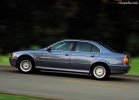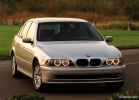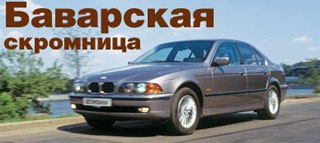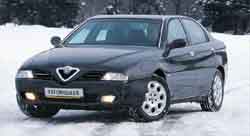Test drive BMW 5 series E39 2000 - 2003 sedan
Five cylinders on the BMW scale
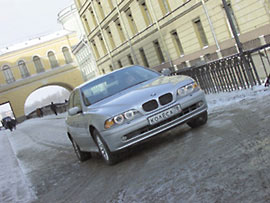 The shark is returning! If you remember, a few years ago, many criticized the licked model of the fifth series for the loss of a fair amount of external aggressiveness for which the cars of the Bavarian brand are so appreciated. However, last fall, the five suffered a light facelifting, during which new block factor with a brilliant designer find: with overall lights in the form of four rings around the reflectors of the main headlights. The face of the car immediately transformed: the features of the sea predator, having rushed his empty, but hypnotizing look at the next victim, are again guessed in it. And even a massive, tightly knocked body of a car, looking like a large -caliber shell, seems more energetic and swift.
The shark is returning! If you remember, a few years ago, many criticized the licked model of the fifth series for the loss of a fair amount of external aggressiveness for which the cars of the Bavarian brand are so appreciated. However, last fall, the five suffered a light facelifting, during which new block factor with a brilliant designer find: with overall lights in the form of four rings around the reflectors of the main headlights. The face of the car immediately transformed: the features of the sea predator, having rushed his empty, but hypnotizing look at the next victim, are again guessed in it. And even a massive, tightly knocked body of a car, looking like a large -caliber shell, seems more energetic and swift. What else has changed? Not so much - the form of facing the radiator, famous nostrils, and the front bumper. In the rear flashlights, LEDs are now used instead of light bulbs. New six -cylinder engines appeared, including a three -liter engine with a capacity of 231 liters. With. The five in modification 530ia, that is, with an automatic gearbox, visited our test.
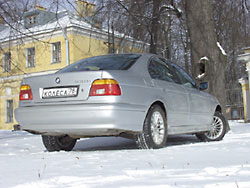 Brief biographical certificate. Information about the BMW of the fifth series of the fourth generation (factory index E39) was first published in the spring of 1995, although the car entered dealers only in December. Two years later, the Touring station wagon entered the market, and in the fall of 1998 the sports M5 debuted. In the summer of 1999, the assembly of sedans with gasoline engines began at the Kaliningrad enterprise Autotor, where it continues with success. According to the German side, the quality of the fives of the Russian assembly is even higher than that of the Munich machines - thanks to more careful control over the production process and the fact that the equipment installed in Kaliningrad is six years younger than the equipment of the head plant. To date, the BMW 530 IA occupies the upper line in the line of product products - both in price and in running characteristics. So, this is the most-most in all respects a serial car assembled in Russia. We met him.
Brief biographical certificate. Information about the BMW of the fifth series of the fourth generation (factory index E39) was first published in the spring of 1995, although the car entered dealers only in December. Two years later, the Touring station wagon entered the market, and in the fall of 1998 the sports M5 debuted. In the summer of 1999, the assembly of sedans with gasoline engines began at the Kaliningrad enterprise Autotor, where it continues with success. According to the German side, the quality of the fives of the Russian assembly is even higher than that of the Munich machines - thanks to more careful control over the production process and the fact that the equipment installed in Kaliningrad is six years younger than the equipment of the head plant. To date, the BMW 530 IA occupies the upper line in the line of product products - both in price and in running characteristics. So, this is the most-most in all respects a serial car assembled in Russia. We met him. Inside, restrained, even somewhat gloomy luxury dominates. Literally about every detail can be said: expensive and concise. The leather -dried interior of the five is a modern interpretation of the family design - many solutions are well known to everyone who went to BMW. Very visible dashboard and steering wheel. The front panel of large forms majestically and smoothly flows into the decoration of the doors, which is emphasized by the original arrangement of the side deflectors of the ventilation system. The central console is occupied by a radio and a microclimate control unit, designed in a single style, they do not attract attention to themselves, but upon closer examination, many buttons with expressive iconograms and dim, but well -read displays eloquently indicate their remarkable opportunities. And in the case, these systems, like all others, fully justify expectations. That is, they quite accurately reflect the spirit of the five.
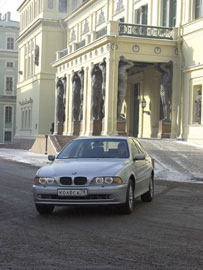 An incomparable driver's seat - harsh, with reliable lateral support - is regulated not only in the longitudinal direction, along the corner of the back and height, but can still rotate around the horizontal axis, like a rocking chair. Solid adjustment ranges will conveniently get a person of any complexion in it and spend several hours behind the wheel without a hint of fatigue. Tested themselves. Nine (!) Control buttons of the most commonly used functions are carried out on the multifunctional ruler. The steering wheel is good in frictional properties and has a convincing adjustment in height, but its rim is thinner than we would like.
An incomparable driver's seat - harsh, with reliable lateral support - is regulated not only in the longitudinal direction, along the corner of the back and height, but can still rotate around the horizontal axis, like a rocking chair. Solid adjustment ranges will conveniently get a person of any complexion in it and spend several hours behind the wheel without a hint of fatigue. Tested themselves. Nine (!) Control buttons of the most commonly used functions are carried out on the multifunctional ruler. The steering wheel is good in frictional properties and has a convincing adjustment in height, but its rim is thinner than we would like. We no longer complain about the steering -stroke switches - this is the tribute of the progress and technical advantage of the car. In addition, part of their functions is transferred to two round handles, one of which controls the head light, the second - fog lights. The classic BaemVest dashboard, from the standpoint of today, although it is designed primitively, it is read perfectly. One remark: the tachometer dial in the lower part is overloaded with the picket fence of the ekonometer, the device of dubious value for owners of expensive machines. The stubborn reluctance of the Bavarians to part with him is surprising - they probably use it to demonstrate the modest appetite for such powerful cars.
With the principles of the organization of microclimate, we figured out promptly. We note two most important details: firstly, climate control allows you to set the air flow temperature separately for the driver and right passenger, and secondly, the central deflectors can be adjusted not only to the pressure of the supplied air, but also to its temperature.
There are evidence of the high status of a car in the cabin everywhere: high -quality, pleasant plastic, ubiquitous microlifts - they are equipped with cup holders, handrails, an ashtray and cigarette lighter (by the way, they are part of a specially stipulated smoker bag), a lid that hides a booty socket for an audio cassette from prying eyes . And what are the mirror in the anti -loner visors, the backlight of which automatically turns on when the curtain is shifted! Six airbags of safety pillows are on guard of the safety of the driver and passengers: two front, two side - in the doorway and two in the tank racks, the so -called ITS (Integrated Tubular Sidebag), which first appeared on fives in 1997. The victim of such an extensive protection system has traditionally became a glove box that degenerated into a small container with a lid, which strives to rest on the knees of the front passenger.
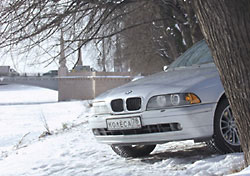
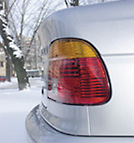
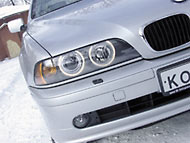
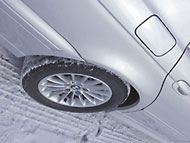
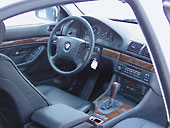
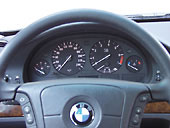
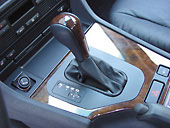
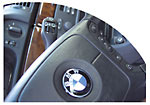
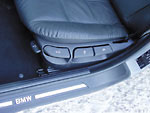
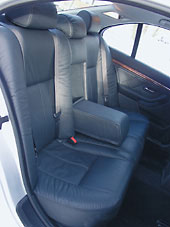
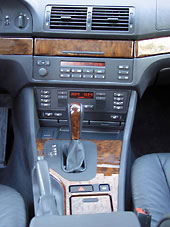
Source: Wheel magazine [No. 46/2001]
Test drives BMW 5 Episode E39 2000 - 2003
Malfunctions BMW 5 E39 2000 - 2003 series
BMW 5 series of sedan: Detailed information| Episode 5 E39 2000 - 2003 | |
|---|---|
| Engine |  |
| Transmission |  |
| Control system and suspension |  |
| Brake system |  |
| Air heating and air conditioning |  |
| Launch and charging system |  |
| Electric components and so on |  |
| Corrosion body stability |




